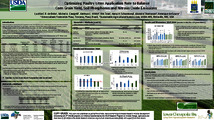Optimizing poultry litter application rate to balance corn grain yield, soil phosphorus and nitrous oxide emissions.
Optimizing poultry litter application rate to balance corn grain yield, soil phosphorus and nitrous oxide emissions.
Author(s): BRITO, L. C. R. de; CAVIGELLI; WHITE, K. E.; TRAN, N.; SCHOMBERG, H. H.; THOMPSON, A.; SOUZA, H. A. de
Summary: Determining optimal poultry litter (PL) application rates for long term use is challenging due to the poorly characterized effect of antecedent applications on soil fertility, especially in organic grain systems where livestock manures which provide multiple nutrients in ratios different than crop needs are often a dominant nutrient input. Evidence from the long term Farming Systems Project (FSP) in Beltsville, Maryland, USA (established 1996) suggests that repeated applications of PL at University recommended rates especially in shorter rotations are greater than optimal to meet agronomic and environmental goals of sustainability (Table 1).
Publication year: 2020
Types of publication: Abstract in annals or event proceedings
Unit: Embrapa Mid-North
Keywords: Cama de frango, Rendimento, Sistemas de grãos orgânicos
Observation
Some of Embrapa's publications are published as ePub files. To read them, use or download one of the following free software options to your computer or mobile device. Android: Google Play Books; IOS: iBooks; Windows and Linux: Calibre.
Access other publications
Access the Agricultural Research Database (BDPA) to consult Embrapa's full library collection and records.
Visit Embrapa Bookstore to purchase books and other publications sold by Embrapa.

